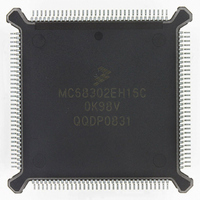MC68302EH16C Freescale Semiconductor, MC68302EH16C Datasheet - Page 243

MC68302EH16C
Manufacturer Part Number
MC68302EH16C
Description
IC MPU MULTI-PROTOCOL 132-PQFP
Manufacturer
Freescale Semiconductor
Datasheets
1.MC68302AG20C.pdf
(4 pages)
2.MC68302AG20C.pdf
(2 pages)
3.MC68302AG20C.pdf
(13 pages)
4.MC68302EH16C.pdf
(481 pages)
Specifications of MC68302EH16C
Processor Type
M683xx 32-Bit
Speed
16MHz
Voltage
5V
Mounting Type
Surface Mount
Package / Case
132-MQFP, 132-PQFP
Controller Family/series
68K
Core Size
32 Bit
Ram Memory Size
1152Byte
Cpu Speed
16MHz
No. Of Timers
3
Embedded Interface Type
SCP, TDM
Digital Ic Case Style
PQFP
Rohs Compliant
Yes
Family Name
M68000
Device Core
ColdFire
Device Core Size
32b
Frequency (max)
16MHz
Instruction Set Architecture
RISC
Supply Voltage 1 (typ)
5V
Operating Temp Range
0C to 70C
Operating Temperature Classification
Commercial
Mounting
Surface Mount
Pin Count
132
Package Type
PQFP
Lead Free Status / RoHS Status
Lead free / RoHS Compliant
Features
-
Lead Free Status / Rohs Status
RoHS Compliant part
Electrostatic Device
Available stocks
Company
Part Number
Manufacturer
Quantity
Price
Company:
Part Number:
MC68302EH16C
Manufacturer:
Freescale Semiconductor
Quantity:
135
Company:
Part Number:
MC68302EH16C
Manufacturer:
PANA
Quantity:
99
Company:
Part Number:
MC68302EH16C
Manufacturer:
Freescale Semiconductor
Quantity:
10 000
Part Number:
MC68302EH16C
Manufacturer:
FREESCALE
Quantity:
20 000
Company:
Part Number:
MC68302EH16CB1
Manufacturer:
Freescale Semiconductor
Quantity:
10 000
Company:
Part Number:
MC68302EH16CR2
Manufacturer:
Freescale Semiconductor
Quantity:
10 000
- MC68302AG20C PDF datasheet
- MC68302AG20C PDF datasheet #2
- MC68302AG20C PDF datasheet #3
- MC68302EH16C PDF datasheet #4
- Current page: 243 of 481
- Download datasheet (2Mb)
the protocol encoding itself. For instance, in a multiplexer, data from a high-speed time-mul-
tiplexed serial stream is multiplexed into multiple low-speed data streams. The concept is to
switch the data path but not alter the protocol encoded on that data path.
By appropriately setting the SCC mode register, any of the SCC channels can be configured
to function as a transparent controller. Transparent mode is achieved by setting the SCM
MODE1–MODE0 bits to 11 and setting the NTSYN bit (bit 13) to 1. Note that, if the NTSYN
bit is cleared, normal BISYNC operation will occur rather than transparent operation. See
4.5.13 BISYNC Controller for a description of BISYNC operation.
The SCC in transparent mode can work with IDL, GCI (IOM-2), PCM highway, or NMSI in-
terfaces. When the SCC in transparent mode is used with a modem interface (NMSI), the
SCC outputs are connected directly to the external pins. The modem interface uses seven
dedicated pins: transmit data (TXD), receive data (RXD), receive clock (RCLK), transmit
clock (TCLK), carrier detect or carrier detect sync (CD), clear to send (CTS), and request to
send (RTS).
The transparent controller consists of separate transmit and receive sections whose opera-
tions are asynchronous with the M68000 core and may be either synchronous or asynchro-
nous with respect to the other SCCs. Transparent mode on the MC68302 is a synchronous
protocol; thus, a clock edge must be provided with each bit of data received or transmitted.
Each clock can be supplied from either the internal baud rate generator or from external
pins. More information on the baud rate generator is available in 4.5.2 SCC Configuration
Register (SCON).
The main transparent controller features are as follows:
4.5.16.1 Transparent Channel Buffer Transmission Processing
When the M68000 core enables the transparent transmitter, it will start transmitting ones.
The transparent controller then polls the first BD in the transmit channel's BD table approx-
imately every 16 transmit clocks. When there is a buffer to transmit, the transparent control-
ler will fetch the data from memory and start transmitting the buffer. Transmission will not
begin until the internal transmit FIFO is preloaded and the SCC achieves synchronization.
See 4.5.16.5 Transparent Synchronization for details of the synchronization process.
When a BD's data is completely transmitted, the last bit (L) is checked in the BD. If the L bit
is cleared, then the transmitter moves immediately to the next buffer to begin its transmis-
sion, with no gap on the serial line between buffers. Failure to provide the next buffer in time
results in a transmit underrun, causing the TXE bit in the transparent event register to be set.
MOTOROLA
• Flexible Data Buffers
• External Sync Pin or BISYNC-Like Frame Sync on Receive
• Reverse Data Mode
• Interrupts on Buffers Transmitted or Received
• Clear to Send and Carrier Detect Lost Reporting
• Maskable Interrupt Available on Each Character Received
• Three Commands
MC68302 USER’S MANUAL
Communications Processor (CP)
4-123
Related parts for MC68302EH16C
Image
Part Number
Description
Manufacturer
Datasheet
Request
R
Part Number:
Description:
Manufacturer:
Freescale Semiconductor, Inc
Datasheet:

Part Number:
Description:
MC68302 Configuring the Chip Selects on the MC68302
Manufacturer:
Motorola / Freescale Semiconductor

Part Number:
Description:
MC68302 Design Concept - Expanding Interrupts on the MC68302
Manufacturer:
Motorola / Freescale Semiconductor

Part Number:
Description:
MC68302 MC68302 Adapting a WAN Controller to a LAN Environment
Manufacturer:
Motorola / Freescale Semiconductor

Part Number:
Description:
MC68302 EKB Applications - Power Measurements on the MC68302
Manufacturer:
Motorola / Freescale Semiconductor

Part Number:
Description:
MC68302 Interfacing the MC68020 to a Slave MC68302
Manufacturer:
Motorola / Freescale Semiconductor

Part Number:
Description:
MC68302 MC68302 Software Performance
Manufacturer:
Motorola / Freescale Semiconductor

Part Number:
Description:
MC68302 Evaluating EDX on the ADS302
Manufacturer:
Motorola / Freescale Semiconductor

Part Number:
Description:
MC68302 Design Advisory #1 - MC68SC302 Passive ISDN Protocol Engine
Manufacturer:
Motorola / Freescale Semiconductor

Part Number:
Description:
MC68302, MC68360, and MPC860 Characteristics and Design Notes for Crystal Feedback Oscillators
Manufacturer:
Motorola / Freescale Semiconductor
Part Number:
Description:
Mc68302 Integrated Multi-protocol Processor
Manufacturer:
Freescale Semiconductor, Inc
Datasheet:
Part Number:
Description:
Manufacturer:
Freescale Semiconductor, Inc
Datasheet:
Part Number:
Description:
Manufacturer:
Freescale Semiconductor, Inc
Datasheet:
Part Number:
Description:
Manufacturer:
Freescale Semiconductor, Inc
Datasheet:
Part Number:
Description:
Manufacturer:
Freescale Semiconductor, Inc
Datasheet:











